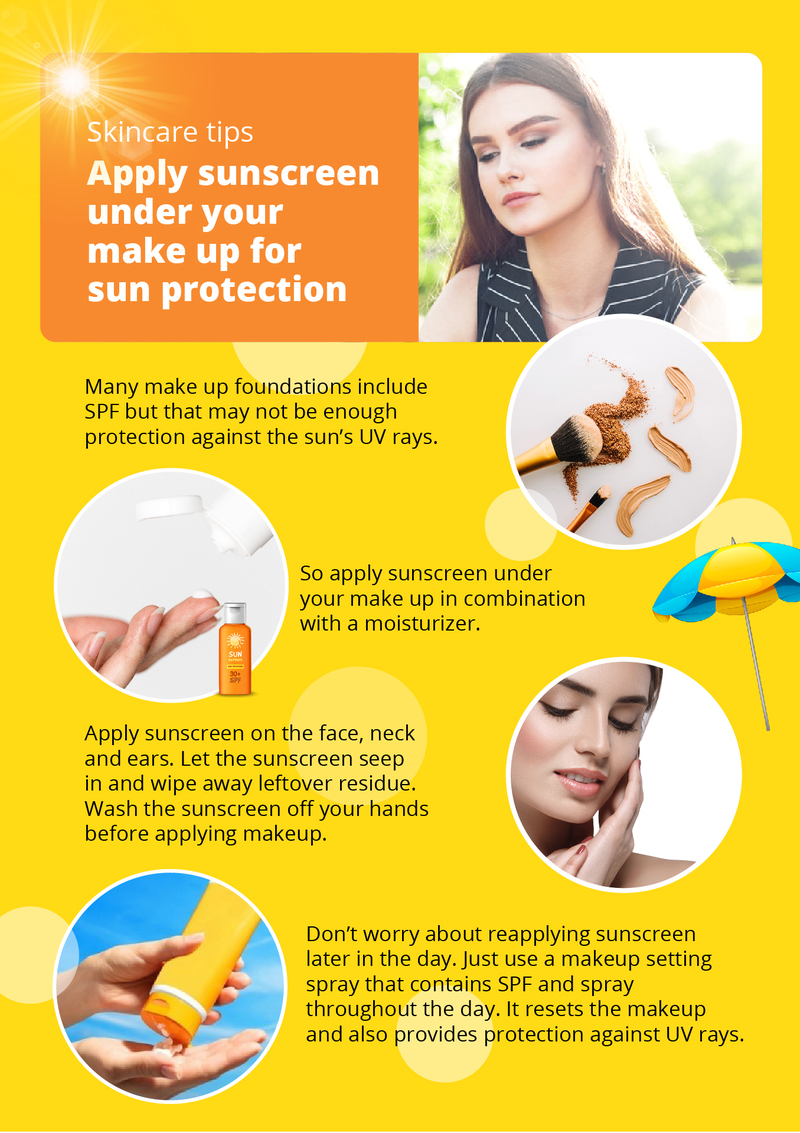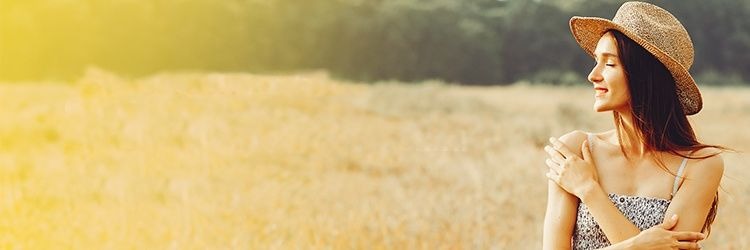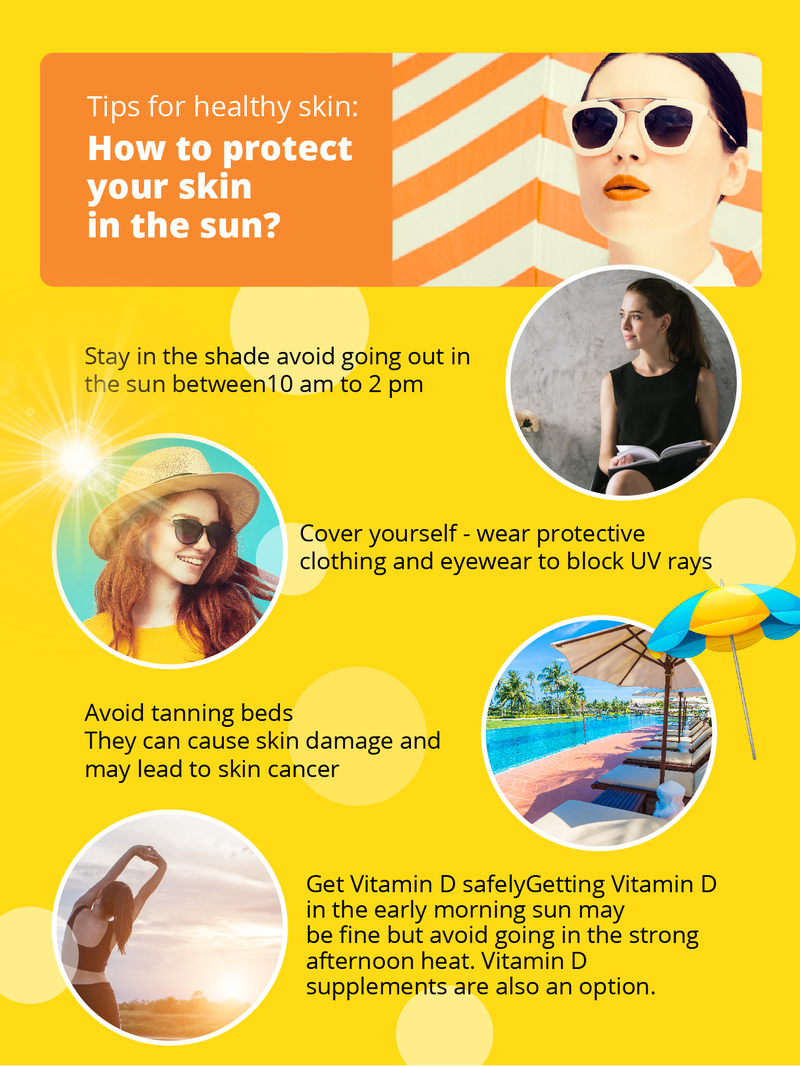Sunscreen or sunblock is a product (it maybe a lotion, spray or gel) that absorbs or reflects the sun’s ultraviolet (UV) rays, helping to protect the skin against sunburn or tanning. Persistent use of sunscreen may also slow down the aging process, or in some cases, temporarily prevent wrinkles, sagging skin or moles. Generally sunscreens are divided into 2 types: Physical sunscreens that reflect the sunlight and Chemical sunscreens that absorb UV rays The sun’s UV rays are harmful and can cause skin damage including skin cancer. Reputed medical institutions such as the American Cancer Society recommends the use of sunscreen while going out in the sun as it helps in the prevention of squamous cell carcinoma. According to experts, after gathering, studying and analyzing the relevant data, they have concluded that the potential risk of not using sunscreen far outweighs the risks of using sunscreen.1
-
What to look for in a sunscreen?
-
Choose the right SPF
-
Protection against both UVA and UVB
-
What are the ingredients in your sunscreen?
-
Know your skin type
-
Is it water resistant?
-
Make sure that your sunscreen has an expiry date
-
Tips for healthy skin: How to protect your skin in the sun?
-
Skincare tips: Apply sunscreen under your make up for sun protection
But there are hundreds of sunscreens available in the market all claiming to offer effective protection against UV rays. So what are the factors that you need to gauge before you select the sunscreen that is most suitable for you?
SPF means Sun Protection Factor which measures the level of UVB protection the product will provide. A high SPF means you can spend more time in the sun while using that particular sunscreen. The American Academy of Dermatology (AAD) recommends a water-resistant sunscreen with a minimum SPF of 30 that provides broad spectrum protection. SPF 15 protects against 93% of the sun’s UVB rays whereas SPF 30 protects against 97% of the sun’s UVB rays. The higher SPFs, such as SPF 50, block out 98% of the sun’s rays and are recommended for fair skin types whose skin burns easily. Of course, as no sunscreen can block out 100% of the UVB rays, the AAD does not recommend maxing out the SPF. 2 Normally an SPF from 30 to 50 will provide effective protection against UVB rays. La Shield sunscreen gel contains SPF 40 that blocks 97.5% of the sun’s UVB rays and is ideal for the level of sun exposure on Indian skin.
Sunlight is made up of two types of harmful rays – long wave ultraviolet A (UVA) and short wave ultraviolet B (UVB). As UVA rays penetrate deep into the dermis, the skin’s thickest layer, unprotected exposure can cause wrinkles and premature aging. UVB rays are also harmful as they usually burn the superficial layers of the skin which may lead to development of skin cancer. Thus, while choosing your sunscreen make sure that the product offers both UVA and UVB protection, or broad spectrum as it is commonly known, to your skin. La Shield sunscreen gel has UVA & UVB filters that provide intense broad spectrum protection.
Active ingredients in the sunscreen absorb or reflect the sun’s rays. Chemical compounds such as avobenzone, bemotrizinol and biscotizole all provide broad spectrum protection. Especially avobenzone helps absorb harmful UVA rays by penetrating the skin’s surface. Physical compounds such as zinc oxide and titanium dioxide help reflect the sun’s rays away from the skin. Some data shows that it is best to avoid ingredients such as oxybenzone and methylisothiazolinone as they may cause allergic skin reactions. La Shield sunscreen gel includes titanium dioxide that helps reflect the sun’s rays.
Before using a sunscreen it is necessary to find out if it is the correct choice for your skin type. 1. Experts recommend that people with dry skin should opt for sunscreens that contain ingredients such as glycerin, lanolin, oils, silicones (like dimethicone) and aloe. 2.For people who have an oily skin type, sunscreens that are lightweight and gel-based with ingredients such as silica or isododecane work best. 3. For people with sensitive skin, sunscreens that contain physical compounds such as titanium dioxide or zinc oxide are good for use. Sensitive skin types should generally opt for hypoallergenic and fragrance-free sunscreens and avoid sunscreens that include ingredients such as alcohol or preservatives as they may cause skin allergies. 4. People suffering from acne may find using gel-based sunscreens beneficial even though they may contain alcohol. Most normal sunscreens are cream based and tend to be heavy but La Shield[A1] is gel-based, very light on the skin, easy to apply and gives a non-oily smooth finish. It is a non-irritant, dermatologically tested product and is suitable for all skin types including combination skin and can be used by both men and women.
According to the FDA, choosing a water-resistant sunscreen means that its SPF offers protection from the sun’s rays for around 40 minutes while swimming in the water or even while exercising. Of course, no sunscreen is 100% waterproof so very water-resistant or very sweat-resistant products generally offer protection for around 80 minutes. La Shield gel-based sunscreen is a water-resistant product that is designed to not be easily affected by water or allow water to pass through. It offers protection against the sun’s UV rays even while swimming or exercising.
When you select your sunscreen make sure that it comes with an expiry date. Do not use the sunscreen after its expiry as it will be difficult to gauge if the product is still safe and effective to use. If you can’t find an expiration date on the product, consider the expiration date to be 3 years after you purchased it.
















